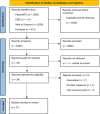What do measures of gender identity tell us about gender identity over time?
- PMID: 38712516
- PMCID: PMC12070138
- DOI: 10.1111/bjdp.12491
What do measures of gender identity tell us about gender identity over time?
Abstract
Gender identity is a multifaceted concept and is represented by a wide range of measures and constructs including both self-report and researcher observations of preferences and behaviours. However, despite their similar theoretical underpinning, gender identity measures are rarely found to correlate with one another, and contrasting patterns and trajectories are often found for each construct (Egan & Perry, Developmental Psychology, 37, 2001, 451). Therefore, this systematic review aimed to present a review of the longitudinal research evidence surrounding gender identity development in the absence of formal intervention. Using a systematic search strategy, 21 studies were identified. Narrative synthesis was used to synthesize the data collected in these studies and trajectories were explored for (1) self-identification measures of gender identity, (2) clothing preferences, (3) peer preferences, and (4) object/activity preferences. Overall, the results of this systematic review are consistent with wider research suggesting that distinct developmental patterns can be observed when using different constructs and measures of gender identity.
Keywords: gender development; gender diversity; gender identity; longitudinal; measures; narrative synthesis; systematic review; transgender.
© 2024 The Authors. British Journal of Developmental Psychology published by John Wiley & Sons Ltd on behalf of British Psychological Society.
Conflict of interest statement
The authors declare no conflict of interest related to this work.
Figures
References
-
- Achenbach, T. M. (2009). The Achenbach system of empirically based assessment (ASEBA): Development, findings, theory, and applications. University of Vermont, Research Center for Children, Youth, and Families.
-
- Amsterdam, B. (1972). Mirror self‐image reactions before age two. Developmental Psychobiology, 5(4), 297–305. - PubMed
-
- Ashmore, R. D. , Deaux, K. , & McLaughlin‐Volpe, T. (2004). An organizing framework for collective identity: Articulation and significance of multidimensionality. Psychological Bulletin, 130(1), 80–114. - PubMed
Publication types
MeSH terms
LinkOut - more resources
Full Text Sources


